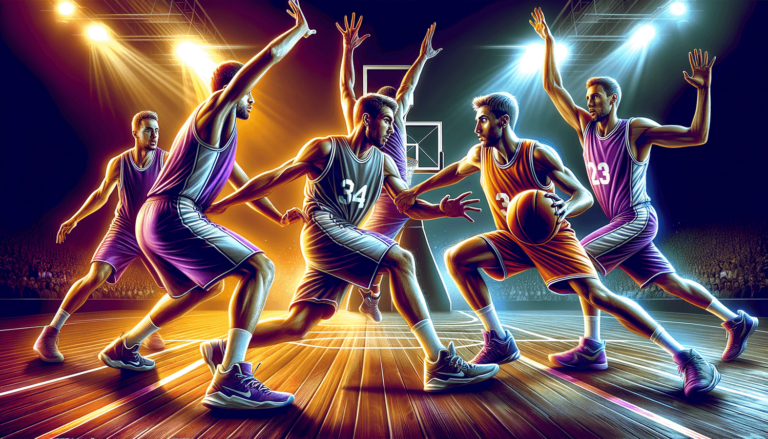
In the fast-paced world of basketball, strategic plays and quick-thinking techniques are essential to staying ahead of the competition. Enter the pindown screen – an often unsung hero within the game’s tactical arsenal. In this blog post, we’ll delve into the intricate details of what a pindown screen is, exploring its purpose, various types, and role in offensive strategies. So lace up your sneakers and get ready for some on-court enlightenment, as we uncover the ins and outs of one of basketball‘s dynamic maneuvers, designed to seamlessly create open looks for shooters to take high percentage shots.
What’s a Pindown Screen in Basketball?
A pindown screen in basketball is a tactical offensive play where a teammate (usually a big man) sets a screen on a defender, allowing a shooter to get open and receive a pass for a high percentage shot. This type of screen is commonly used to create space and scoring opportunities, particularly for sharpshooters and wing players. The player setting the screen typically positions themselves near the low post, while the shooter moves from the weak side to the strong side of the court, using the screen to evade their defender and catch the ball in an optimal shooting position.
Demystifying the Pindown Screen: Its Purpose and Benefits
Before diving into the nitty-gritty of a pindown screen, it’s important to understand its purpose and why it’s such a valuable play in the game of basketball. A pindown screen undoubtedly brings several advantages to the table:
- It creates space for the shooter, providing them with a high-quality scoring opportunity.
- It tests the communication and defensive skills of the opposing team, potentially forcing defensive breakdowns and mismatches.
- It keeps the offense unpredictable and versatile, making it harder for opponents to guard against the playmakers.
Breaking Down the Pindown Screen: Key Components
1. The Setup
Before performing a pindown screen, the offense must establish an appropriate formation. Generally, this involves the shooter on the weak side (the side of the court without the ball) and the screener near the low post. The point guard or playmaker should position themselves at the top of the key, ready to make the pass when the shooter pops open. The timing is critical here to ensure the play is executed seamlessly.
2. The Screen
Setting an effective screen is the key to a successful pindown. The screener should maintain a wide stance and keep their feet firmly planted on the floor while setting the screen for the shooter. Ideally, the screener should be a taller and more robust player, able to block the defender’s attempt to follow the shooter effectively. Communication plays a vital role in this process, as the screener must inform the shooter of the oncoming screen and any potential defensive adjustments.
3. The Footwork
Good footwork is vital for the shooter to effectively use the pindown screen. The shooter should plant and pivot on the foot nearest to the basket as they curl around the screen, making sure to stay close to the screener to minimize the defensive space. As they move, the shooter should focus on maintaining balance and readiness to catch and shoot, as the pass may come quickly once they arrive in the open space.
4. The Pass
Once the shooter has maneuvered around the screen and found open space, the point guard or playmaker must deliver a well-timed and accurate pass. Timing and precision are crucial, as late or inaccurate passes can result in poor shot quality or even turnovers. Reading the defense and anticipating the best passing angle are essential to a successful pindown screen play.
Adapting the Pindown Screen for Different Players and Situations
Double Pindown Screens
For teams with multiple outside shooters, the double pindown screen can be a lethal weapon. In this variation, two screeners set staggered screens for the same shooter, creating multiple layers of separation from the defender. This play is particularly effective for lethal sharpshooters, as it generates more open space and scoring opportunities.
Flare Screens
Sometimes, defenses anticipate the pindown screen and aggressively deny the pass, even switching defenders to stifle the play. A potential counter to this aggressive defense is called a flare screen. In this option, instead of curling toward the ball, the shooter moves parallel to the baseline, away from the ball. The screener then adjusts and sets a “flare screen” which allows the shooter to receive a pass in a separate, open location on the perimeter.
Pop-out and Slash Screens
Another variation that can be applied to the pindown screen is the pop-out and slash screen. If the defender manages to navigate the screen by either going above it or underneath it, the shooter can exploit their defensive choice by utilizing a pop-out or slash screen. A pop-out screen has the shooter moving towards the perimeter rather than curling towards the basket, while a slash screen sends the shooter driving towards the rim.
Big-to-Little and Little-to-Big Screens
Pindown screens don’t exclusively have to be screens set by big men for guards. Teams can take advantage of mismatches by having guards set screens for big men or even having guards screening for other guards. This tactic puts pressure on the defense to switch or fight through the screens, potentially leading to confusion and creating high-percentage shot opportunities.
Defending Against the Pindown Screen
Fighting Through the Screen
The most straightforward method of defending a pindown screen is by fighting through it. This entails following the shooter as closely as possible and navigating around the screener to challenge the shot. Defensive players must use quick footwork and stay low, relying on their strength and agility to get through the screen.
Switching
If the defense anticipates the pindown screen, the players guarding the screener and the shooter may opt to switch assignments. This strategy eliminates the need to fight through the screen and may stifle the scoring opportunity. However, switches can potentially create mismatches if the screen was set correctly, so it’s essential to weigh the risks and benefits when deciding to switch.
Hedging
Hedging involves the defender momentarily stepping out to help the teammate through the screen while simultaneously keeping an eye on their assignment. This method may momentarily contain the shooter and disrupt the timing of the play. Additionally, it’s crucial for defenders to communicate effectively and recover quickly to their respective assignments after hedging.
Putting It All Together: The Real-world Impact of Pindown Screens
In the world of basketball, pindown screens are a critical ingredient in any offensive strategist’s playbook. When executed correctly, they create open, high-percentage shots and provide opportunities for versatile, multi-dimensional offenses. As with any play in basketball, mastering the pindown screen requires practice, communication, and timing. However, once incorporated into a team’s offensive approach, the pindown screen can elevate a team’s game to new levels and create a powerful, dominant presence on the court.
Mastering the Pindown Screen: Drills and Tips
Pindown screens are integral to many basketball offenses, and as with any skill, practice makes perfect. We’ll examine various drills and tips to help players improve their pindown screen execution and efficiently incorporate this powerful play into their range of skills.
1. Three-player Pindown Drill
The three-player pindown drill is a straightforward way to develop on-court communication and timing for pindown screens. This drill requires a point guard, a shooter, and a screener. The players focus on running the pindown play, allowing the shooter to catch and shoot or pass the ball back to the point guard. Completing multiple repetitions of this drill helps ingrain the proper technique, timing, and communication required for an effective pindown screen.
2. Shell Drill
For more advanced practice, the shell drill incorporates defensive players to simulate actual game situations. In this four-on-four or five-on-five drill, the offensive team sets a pindown screen while the defensive team practices switching, hedging, or fighting through the screen. The offense scores points by getting open shots or creating defensive mistakes, while the defense scores by stopping the offensive play. This competitive practice setup familiarizes players with real game conditions, emphasizing the importance of communication and teamwork.
3. Reading the Defense
Practice identifying how the defense reacts to a pindown screen during drills or scrimmages. Recognize when the defender fights through, switches, or hedges, and adapt to their movements by making the appropriate read. Developing this ability to make quick decisions helps players become more versatile and dynamic on the court.
4. Practice Catch-and-Shoot Scenarios
Since pindown screens often lead to quick catch-and-shoot opportunities, it’s essential to work on this skill during practice. Use drills that focus on footwork, balance, and a quick release, ensuring players can effectively catch, set, and shoot the ball in a fluid motion.
Transforming Your Offensive Arsenal with the Pindown Screen
Now that you’re equipped with the knowledge, techniques, and drills to master the pindown screen, it’s time to put it all into action. By incorporating the pindown screen into your basketball offense, you’ll unlock new scoring opportunities and enhance the unpredictability of your team’s attack. Use the tips and techniques mentioned in this article to refine the art of the pindown screen, and watch as your team’s offensive capabilities reach new heights.
FAQ: Pindown Screen in Basketball
Get quick answers to your questions about pindown screens in basketball. Find clarity and learn the nuances of this essential offensive move with our frequently asked questions and NLP-style answers.
1. What is the main purpose of a pindown screen?
The primary purpose of a pindown screen is to create space and scoring opportunities for a shooter in basketball by setting a screen that allows them to break free from their defender.
2. How does a pindown screen differ from other types of screens?
A pindown screen is specifically designed for shooters to get open by positioning the screener near the low post, while the shooter moves from the weak side to the strong side around the screen, creating a high-percentage shot opportunity.
3. What are the key components of an effective pindown screen?
The key components of a successful pindown screen include proper setup, setting an effective screen, efficient footwork by the shooter, and a well-timed and accurate pass from the playmaker.
4. Can pindown screens be used in different offensive situations?
Yes, pindown screens can be adapted to various offensive situations, including double pindown screens, flare screens, pop-out and slash screens, and big-to-little or little-to-big screens, which can exploit mismatches.
5. What are some common defensive strategies against pindown screens?
Defenses can counter pindown screens by fighting through the screen, switching assignments, or hedging to help the teammate while maintaining their defensive position.
6. Can guards set pindown screens as well?
Yes, guards can set pindown screens for other guards or big men to create mismatches, confusion, and scoring opportunities on the court.
7. How can players practice pindown screens?
Players can practice pindown screens through drills like the three-player pindown drill and shell drill, focusing on key aspects like positioning, communication, footwork, and making the right reads.
8. What type of players are typically involved in a pindown screen?
A pindown screen usually involves a shooter (often a guard or wing player), a screener (typically a taller and more robust player like a big man), and a playmaker or point guard responsible for passing the ball to the open shooter.
9. Why is good footwork crucial for successful pindown screens?
Good footwork enables the shooter to effectively move around the screen, maintain balance, and stay prepared to catch and shoot, while the defender uses their agility to fight through the screen or switch assignments.
10. How does the flare screen counter aggressive defense on a pindown screen?
The flare screen is a counter to aggressive defense by having the shooter move parallel to the baseline, away from the ball, instead of curling toward it. The screener sets a flare screen to help the shooter receive a pass in an open location on the perimeter.
Featured Posts
- No pillar pages found.





